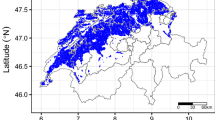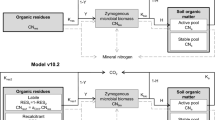Summary
NCSWAP (nitrogen and carbon cycling in soil, water and plant) is a simulation model of the soil-crop-water system which integrates water flow dynamics, crop growth, N transformations, tillage and residue effects, soil temperature, and solute transport. A small plot field study was initiated in May of 1980 to determine the effects of N rate (2 or 20 g N/m2), tillage (rototill or no-till), and residue management system (residue return or noresidue) on soil parameters, and maize (Zea mays L.) production.
Significant differences due to treatments (N rate, tillage, and residue) were not detected in 1981 for the measured soil-plant parameters including soil moisture, yield, and N uptake. Therefore, two representative treatment combinations (N rates of 2 or 20 g N/m2-tilled-no residue) characterized the field research data. Calculated and observed data sets were compared for several parameters including: (1) soluble NO3−N, (2) N leaching losses (3) plant total-N and15N, (4) root growth, (5) soil moisture, and (6) fertilizer efficiency.
The objectives of this study were to initiate the validation process of the model NCSWAP, and to illustrate how NCSWAP can be used as a research tool to infer operational characteristics of the N cycle.
Similar content being viewed by others
References
Bremner J M and Mulvaney C S 1983 Nitrogen-total.In Methods of Soil Analysis, Part 2. Eds A L Page, R H, Miller and D R Keeney (2nd ed.). Agronomy 9, pp 595–622. Am. Soc. Agron, Madison, WI.
Cahoon G A and Morton E S 1961 An apparatus for the quantitative separation of plant roots from soil. Am. Soc. Hort. Sci. Proc. 78, 593–596.
Clapp C E, Newman T C, Marten G C and Larson W E 1984 Effects of municipal waste-water effluent and cutting management on root growth of perennial forage grasses. Agron. J. 76, 642–647.
Clay D E, Molina J A E, Clapp C E and Linden D E 1985 Nitrogen-tillage-residue management: 2. Calibration of potential rate of nitrification by model stimulation. Soil Sci. Am. J. 49,In press.
Deans J R, Clapp C E, Molina J A E, Klair K S, Shaffer M J and Durben N J 1984 Maize dry matter production as related to biological nitrogen availability indexes. Proc. 2nd Intern. Symp. on Peat and Organic Matter in Agric. and Hort. pp 119–130. Volcani Center, Bet Dagan Israel.
Edwards A P 1978 A guide to the use of14N and15N in environmental research. CRREL Special Report 78-18. US Army Corps of Engineers, Hanover, NH.
Gupta S C, Larson W E and Linden D R 1983 Tillage and surface residue effects on soil upper boundary temperatures. Soil Sci. Soc. Am. J. 47, 1212–1218.
Gupta S C, Radke J K, Larson W E and Shaffer M J 1982 Predicting temperatures of bare and residue-covered soils from daily maximum and minimum air temperatures. Soil Sci. Soc. Am. J. 46, 372–376.
Keeney D R 1982 Nitrogen-availability indices.In Methods of Soil Analysis, Part 2 Eds. A L Page, R H Miller and D R Keeney (2nd ed.). Agronomy 9, pp 711–733. Am. Soc. Agron., Madison, WI.
Linden D R 1977 Design, installation and use of porous ceramic samplers for monitoring soil water quality. USDA-ARS Tech. Bull. 1562.
Molina J A E, Clapp C E and Larson W E 1980 Potentially mineralizable nitrogen in the soil: The simple exponential model does not apply for the first twelve weeks of incubation. Soil Sci. Soc. Am. J. 44, 442–443.
Molina J A E, Clapp C E, Shaffer M J, Chichester F W and Larson W E 1983 NCSOIL, a model of nitrogen and carbon transformation in soil: description, calibration and behavior. Soil Sci. Soc. Am. J. 47, 85–91.
Molina J A E and Richards K 1984 Simulation model of the nitrogen and carbon cycle in the soil-water-plant system, NCSWAP; Guide for the preparation of input data files and execution of NCSWAP. Soil Series 116. Department of Soil Science, University of Minnesota, St. Paul, MN.
Newman T C, Clapp C E, Larson W E, Marten G C and Palazzo A J 1983 Effects of muni cipal wastewater effluent on root growth of two perennial forages and corn CRREL Technical Note. US Army Corps of Engineers, Hanover, NH.
Stanford G and Smith S J 1972 Nitrogen mineralization potentials of soils. Soil Sci. Soc. Am. Proc. 36, 465–472.
Voorhees W B, Carlson V A and Hallauer E A 1980 Root length measurement with a computer-controlled digital scanning micro-densitometer. Agron. J. 72, 847–851.
Author information
Authors and Affiliations
Additional information
Contribution of the Soil and Water Management Research Unit, USDA-ARS, and the Department of Soil Science, University of Minnesota, St. Paul, MN 55108. Minn Agric. Exp. Sta., Sci. J., Ser. Paper 13907.
Senior Laboratory Technician; Research Chemist, USDA-ARS and Professor; Professor of Soil Microbiology; and Soil Scientist, USDA-ARS and Assistant Professor; all Department of Soil Science, University of Minnesota, respectively. Inquiries about NCSWAP should be sent to J. A. E. Molina.
Rights and permissions
About this article
Cite this article
Clay, D.E., Clapp, C.E., Molina, J.A.E. et al. Nitrogen-tillage-residue management. Plant Soil 84, 67–77 (1985). https://doi.org/10.1007/BF02197868
Received:
Revised:
Issue Date:
DOI: https://doi.org/10.1007/BF02197868




